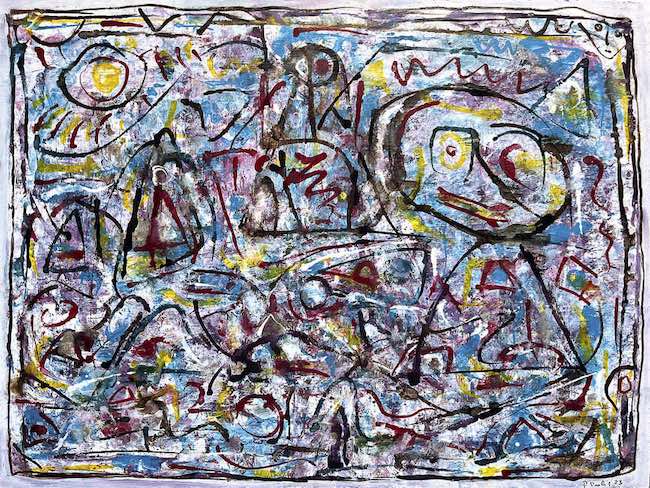Esistono, nel panorama artistico attuale, autori che necessitano compiere un percorso introspettivo, spesso persino solitario, per poter analizzare e comprendere tutto ciò che galleggia all’interno delle proprie profondità, riuscendo attraverso un’osservazione delle sfaccettature interpretative che ogni esperienza offre, a rappresentare attraverso la loro creatività quel mondo interiore che solo attraverso il silenzio riesce a trovare voce; e poi ne esistono altri per cui il contatto con la moltitudine, il relazionarsi con individui conosciuti o sconosciuti, costituisce una vera e propria linfa vitale a cui attingere per generare la più vera espressione artistica, quella che li mette in stretta relazione con tutto ciò che accade loro intorno e di cui non sono primi attori bensì co-protagonisti insieme a quella moltitudine di cui tanto amano circondarsi. L’artista di cui vi racconterò oggi mostra nelle sue opere l’attitudine a voler essere parte di quelle comunità che si muovono, vivono, ridono e si divertono proprio in virtù della scelta di stare insieme per assaporare tutte le nuove avventure davanti a cui la vita le mette.
Intorno agli anni Ottanta del Novecento sorse negli Stati Uniti un movimento pittorico che di fatto non aveva linee guida né regole se non quelle di parlare al popolo, a tutte quelle persone che non erano abituate a frequentare le gallerie d’arte e che ogni giorno riempivano le strade americane per andare al lavoro; la Street Art era un’espressione dei messaggi interiori dei suoi autori, spesso arrabbiati, emarginati, esclusi, rifiutati dai circuiti delle grandi gallerie pur senza mai rassegnarsi a rimanere in silenzio. I loro messaggi erano chiari, facilmente comprensibili dalla massa, in altri casi invece più ermetici, e basilare era il linguaggio espressivo proprio perché spogliato da ogni tecnica tradizionale, da ogni ricercatezza stilistica che avrebbe solo tolto immediatezza al concetto, spesso urlato in modo aggressivo, che era necessario esprimere. Due tra i principali rappresentanti furono Jean-Michel Basquiat e Keith Haring, tanto amici nella vita e solidali nel trovare un proprio posto in un mondo che sembrava volerli rifiutare, quanto diversi nella cifra pittorica attraverso cui manifestavano contestualmente la loro fragilità ma anche la forza e il coraggio di uscire dagli schemi inventando qualcosa di nuovo. La pittura di Basquiat era segnica, attingeva al Graffitismo primitivo perché attraverso la semplicità era maggiormente possibile lasciar fluire tutta la rabbia per il suo essere vissuto ai margini, tossicodipendente e senzatetto, uomo di colore in una società americana ancora incapace di accogliere la diversità; quella di Keith Haring invece più fumettistica, più figurativa e al contempo complessa e sfaccettata per i significati che oltre quel tratto grafico quasi basico si nascondevano, come l’omosessualità ancora non completamente accettata dalla comunità o le sue idee sui temi sociali. Ciò che colpisce di entrambi è la capacità comunicativa ma anche il destino che malgrado l’intenzione iniziale di voler parlare alle persone comuni, li ha fatti diventare tra gli artisti più quotati di tutti i tempi. In qualche modo la loro amicizia li ha resi quasi due facce della stessa medaglia, quella voglia di innovazione, quel desiderio solidale di sostenersi nelle difficoltà e la necessità di raccontare ciascuno a proprio modo la realtà di quell’epoca. Entrambi legati al segno reinterpretato e declinato secondo l’attitudine espressiva, hanno saputo dare vita a un modo differente di essere artisti, lasciando fuoriuscire il desiderio di rivolgersi a un pubblico non necessariamente colto ma sensibile all’arte. L’artista austriaco Peter Seelig dà vita a una sua cifra stilistica in cui sono presenti tratti riconducibili a Jean-Michel Basquiat e a Keith Haring perché se è vero che il suo segno grafico è essenziale, in alcuni casi appena accennato per lasciar voce ai colori, lo è anche che le sue opere mostrano costantemente un reticolo di esistenze, una moltitudine di persone che interagiscono tra loro e da cui l’artista non riesce a distaccarsi, come se esse fossero l’ispirazione a cui attingere per la sua pittura.
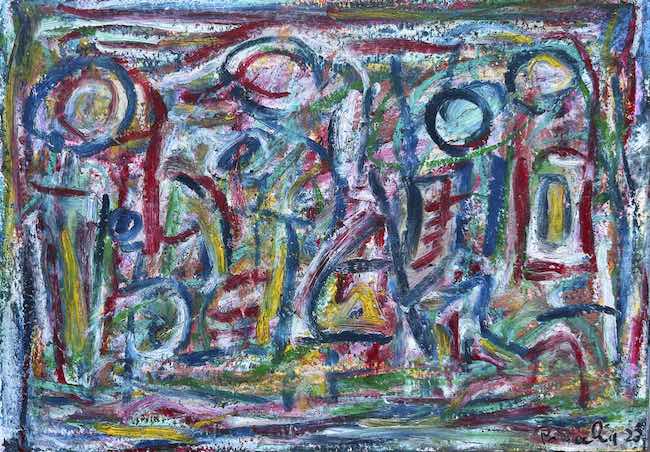
In qualche modo però Seelig sembra oltrepassare la figurazione, lascia che ai colori la voce interpretativa del frangente che sceglie di narrare avvicinandosi così a una sorta di Espressionismo Astratto dove il contorno, quello che dovrebbe delimitare le figure protagoniste, diviene sfumato, impalpabile proprio per lasciare spazio alla sensazione generale.
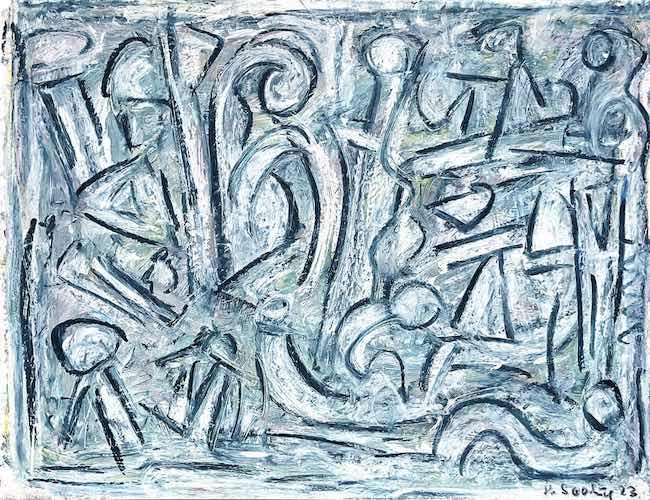
Di Keith Haring riprende invece la caratteristica di mettere su tela, o su carta, l’idea della massa di persone che si incontrano e si parlano quotidianamente, come se in qualche modo l’esistenza assumesse un senso diverso nel momento in cui l’individuo esce da se stesso e si connette con tutto ciò che lo circonda; il collegamento tra gli individui evidente nello street-artist del secolo scorso, si amplia in Peter Seelig perché in lui tutto viene vissuto con l’approccio divertito alla vita che lo contraddistingue, dove ogni giorno è una scoperta, un’occasione per assaporare le circostanze con tutto ciò che possono offrire. La gamma cromatica è variegata, si adegua alla sensazione che l’artista desidera esprimere e a cui spesso sceglie di non dare una definizione, lasciando le opere senza titolo per non condizionare il sentire dell’osservatore e per non guidarne l’interpretazione perché per Peter Seelig l’esperienza artistica, così come quella dell’esistenza, è un modo per lasciar fluire le emozioni, aprendosi a tutto ciò che può accadere, raccontando senza utilizzare le parole, e dunque anche chi fruisce delle sue opere deve avere la stessa apertura nei confronti di quanto si trova davanti ai suoi occhi.
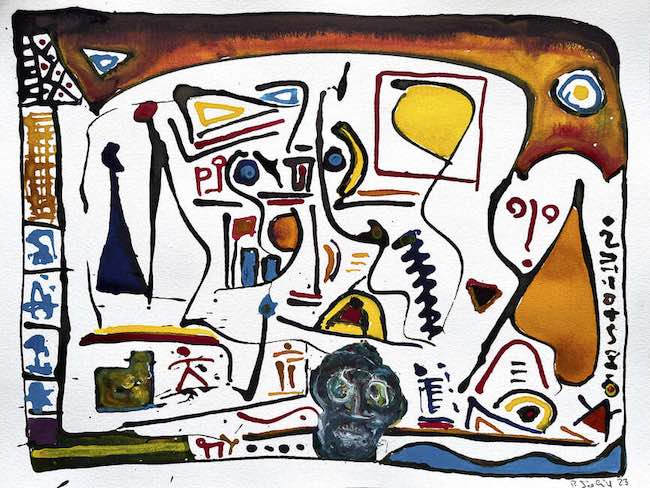
I volti primitivi e semplificati sono spesso affiancati a una pittura segnica che si collega all’immediatezza di Joan Mirò, un surrealista fuori dagli schemi in cui l’indefinitezza e la semplicità espressiva erano funzionali a collegare l’uomo al suo lato più fanciullesco, più spontaneo; in Seelig questa pittura segnica è utilizzata per descrivere una sensazione che si lega a una storia, a qualcosa di vissuto e che diventa occasione per raccontare attraverso i colori gli eventi che si sono susseguiti e che si sono impressi nella sua memoria fino a quando l’impulso non lo ha spinto a tradurre tutto sotto forma d’arte.
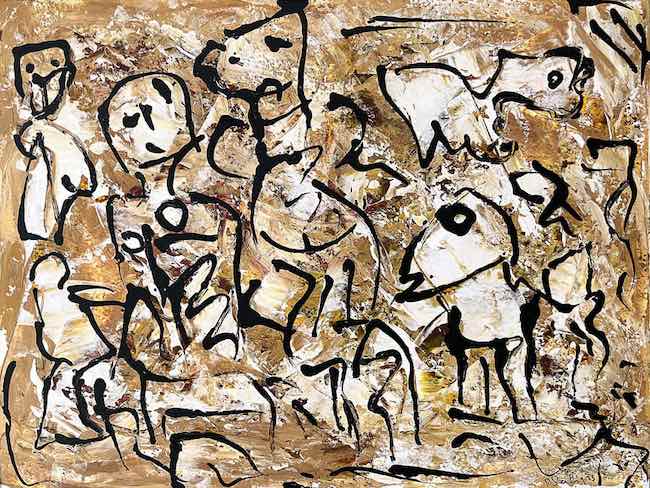
Le sue opere degli ultimi anni sono realizzate prevalentemente su carta perché la superficie liscia rende più veloce la realizzazione, così come amplia la possibilità di scegliere tra diverse opzioni esecutive, passando dall’acrilico e inchiostro alla tecnica mista, dalla china al pastello a olio, senza lasciar prevalere una tecnica sull’altra sulla base di un ragionamento logico bensì semplicemente lasciandosi andare all’istinto del momento.
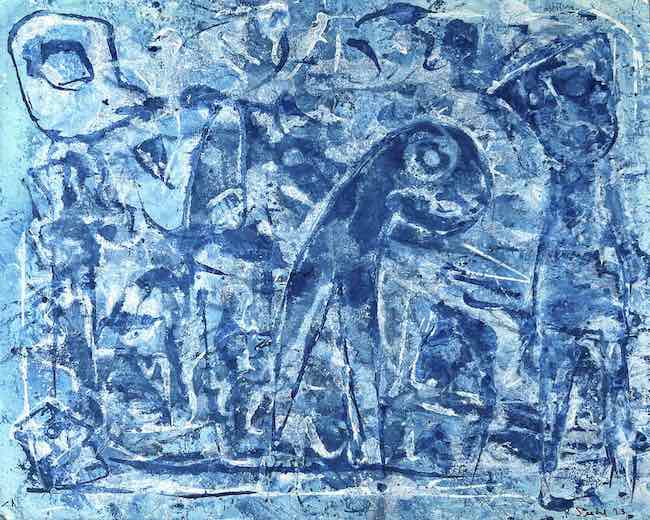
Il senso di comunità è ciò che emerge in maniera chiara dalle opere di Peter Seelig, quell’impulso costante a sentirsi parte di un gruppo di individui con cui condividere le esperienze del frangente presente, sorridendo di quanto si appresta ad accadere allo stesso modo in cui un bambino curioso affronta la meraviglia dell’esistenza; nelle sue opere nessuno dei personaggi viene definito e caratterizzato perché ciò che conta è l’atmosfera generale, quegli istanti che si fissano nella memoria di tutti coloro che condividono gli accadimenti, e che per ciascuno assumono una rilevanza diversa sulla base della personalità.
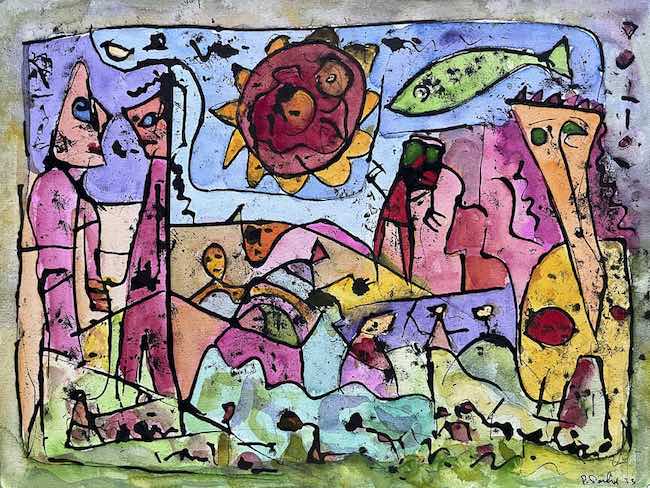
In Bagno Carlo a Pietrasanta invece è visibile una maggiore determinatezza descrittiva, i protagonisti, forse una proiezione di se stesso insieme alla moglie, sembrano tenersi per mano nel ricordare quel frangente estivo di cui sembra emergere il vocìo delle persone che fanno parte dell’opera senza mai diventarne protagonisti; Peter Seelig mette dunque in primo piano il sole della Toscana, il pesce che fa parte della tradizione gastronomica della regione, tutti frammenti di istanti vissuti e che accompagnano l’autore con un senso di nostalgia ma anche di attesa per un prossimo ritorno.
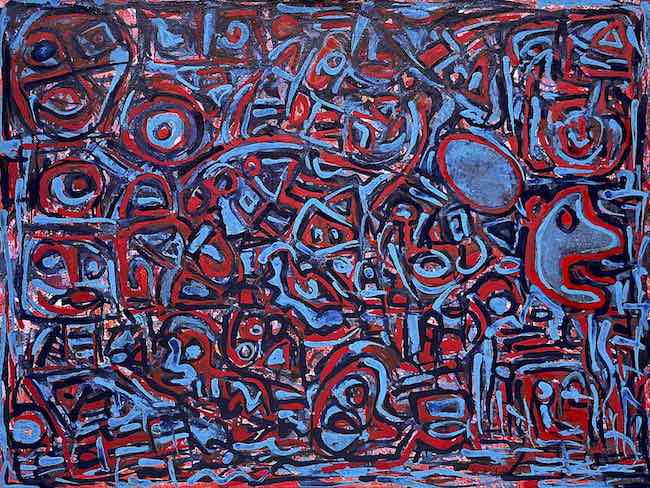
La stilizzazione delle immagini qui è evidente, tanto quanto il ritorno a una figurazione, sebbene molto semplificata, che invece si perde in It’s midnight, how to get from A to B? dove le figure sembrano essere collegate le une alle altre dall’entusiasmo di prolungare il piacere di stare insieme divertendosi. In questa opera si percepisce la leggerezza della condivisione, l’ebbrezza dell’aver assaporato un buon vino e l’incognita di non sapere come proseguire la serata, come se tutto per Peter Seelig fosse una meravigliosa scoperta. Peter Seelig, consulente informatico e sviluppatore di software per professione e artista per vocazione, studioso di matematica, fisica e filosofia, ha al suo attivo un ventennale percorso espositivo che lo ha portato a mostrare le sue opere in diverse città e località dell’Austria, della Francia e dell’Italia – paese quest’ultimo che ha eletto a sua seconda casa -, ricevendo consensi e apprezzamenti dagli addetti ai lavori e dal pubblico.
PETER SEELIG-CONTATTI
Email: peterseelig@hotmail.com
Sito web: www.peterseelig.com/display_portrait.php
Facebook: www.facebook.com/peter.seelig.at
Instagram: www.instagram.com/seeligpeter/
Peter Seelig’s signs painting, between Graffitism and Abstract Expressionism to tell the fascination of life’s interactions
There are, in today’s art scene, authors who need to make an introspective, often even solitary journey in order to analyze and understand all that floats within their own depths, succeeding through an observation of the interpretative facets that each experience offers, to represent through their creativity that inner world that only through silence can find a voice; and then there are others for whom contact with the multitude, relating with known or unknown individuals, constitutes a real lifeblood to draw on in order to generate the truest artistic expression, the one that puts them in close relationship with everything that happens around them and of which they are not first actors but co-protagonists together with that multitude they so love to surround themselves with. The artist I am going to tell you about today shows in his works the attitude of wanting to be part of those communities that move, live, laugh and have fun precisely by virtue of choosing to be together to savor all the new adventures that life puts them before.
Around the 1980s arose in the United States a pictorial movement that in fact had no guidelines or rules except to speak to the people, to all those persons who were not accustomed to frequenting art galleries and who filled the American streets every day to go to work; Street Art was an expression of the inner messages of its authors, often angry, marginalized, excluded, rejected by the circuits of the large galleries while never resigning themselves to remain silent. Their messages were clear, easily understood by the masses, in other cases more hermetic, and basic was the expressive language precisely because it was stripped of any traditional technique, any stylistic refinement that would only detract from the immediacy of the concept, often aggressively shouted, that needed to be expressed. Two of the main representatives were Jean-Michel Basquiat and Keith Haring, as much friends in life and supportive in finding their own place in a world that seemed to want to reject them, as different in the pictorial figure through which they manifested contextually their fragility but also the strength and courage to break out of the mold by inventing something new. Basquiat‘s painting was sign-like, he drew on primitive Graffitism because through simplicity it was more possible to let flow all the anger for his being living on the margins, a drug addict and homeless, a black man in an American society still incapable of accepting diversity; Keith Haring‘s, on the other hand, was more cartoonish, more figurative and at the same time complex and multifaceted because of the meanings that lay hidden beyond that almost basic graphic stroke, such as homosexuality still not completely accepted by the community or his ideas on social issues.
What is striking about both of them is their ability to communicate but also the destiny that despite their initial intention of wanting to speak to ordinary people, made them become among the most quoted artists of all time. Somehow their friendship made them almost two sides of the same coin, that desire for innovation, that sympathetic desire to support each other in difficulties and the need to each tell in their own way the reality of that era. Both linked to the sign reinterpreted and declined according to expressive attitude, they were able to give life to a different way of being artists, letting out the desire to address an audience not necessarily educated but sensitive to art. The Austrian artist Peter Seelig gives life to his own stylistic code in which are present traits attribuitable to Jean-Michel Basquiat and to Keith Haring because if it is true that his graphic sign is essential, in some cases barely hinted at in order to let the colors have a voice, it is also true that his artworks constantly show a network of existences, a multitude of people interacting with each other and from which the artist cannot detach himself, as if they were the inspiration to draw on for his painting. Somehow, however, Seelig seems to go beyond figuration, he lets the colors have the interpretive voice of the juncture he chooses to narrate, thus approaching a kind of Abstract Expressionism where the outline, the one that should delimit the protagonist figures, becomes blurred, impalpable precisely to leave room for the general feeling.
From Keith Haring, on the other hand, he takes up the characteristic of putting on canvas, or on paper, the idea of the mass of people meeting and talking to each other on a daily basis, as if somehow existence takes on a different meaning the moment the individual steps outside himself and connects with everything around him; the connection between individuals evident in the street-artist of the last century, is expanded in Peter Seelig because in him everything is experienced with the amused approach to life that distinguishes him, where every day is a discovery, an opportunity to savor circumstances with all they can offer. The color palette is varied, adapting to the feeling that the artist wishes to express and to which he often chooses not to give a definition, leaving the works untitled so as not to condition the viewer’s feeling and not to guide his interpretation because for Peter Seelig the artistic experience, as well as that of existence, is a way to let emotions flow, opening up to everything that can happen, telling without using words, and therefore those who enjoy his artworks must also have the same openness to what is in front of their eyes. Primitive, simplified faces are often juxtaposed with signs painting that connects with the immediacy of Joan Miró, an out-of-the-box Surrealist in whom indefiniteness and expressive simplicity were functional in connecting man to his more childlike, more spontaneous side; in Seelig, this sign painting is used to describe a feeling that is linked to a story, to something experienced, and that becomes an opportunity to recount through colors the events that followed one another and that were imprinted in his memory until the impulse drove him to translate everything into art form. His works in recent years are mainly made on paper because the smooth surface makes the realization faster, just as it broadens the choice of different execution options, going from acrylic and ink to mixed media, from India ink to oil pastel, without letting one technique prevail over the other basing on logical reasoning but simply letting go of the instinct of the moment.
The sense of community is what emerges clearly from Peter Seelig‘s paintings, that constant impulse to feel part of a group of individuals with whom to share the experiences of the present juncture, smiling at what is about to happen in the same way that a curious child faces the wonder of existence; in his works none of the characters are defined and characterized because what matters is the general atmosphere, those moments that are fixed in the memory of all those who share the happenings, and that for each take on a different relevance based on personality. In Bagno Carlo in Pietrasanta, on the other hand, a greater descriptive determinacy is visible, the protagonists, perhaps a projection of himself together with his wife, seem to hold hands in remembering that summer juncture of which the voices of the people who are part of the work seem to emerge without ever becoming its protagonists; Peter Seelig thus foregrounds the Tuscan sun, the fish that is part of the gastronomic tradition of the region, all fragments of moments experienced and that accompany the author with a sense of nostalgia but also of expectation for a forthcoming return. The stylization of the images here is evident, as much as the return to a figuration, albeit a much simplified one, which, on the other hand, is lost in It’s midnight, how to get from A to B? where the figures seem to be connected to each other by the enthusiasm of prolonging the pleasure of being together while having fun. In this work there is a sense of the lightness of sharing, the elation of having enjoyed a good wine and the unknown of not knowing how to continue the evening, as if everything for Peter Seelig was a wonderful discovery. Peter Seelig, a computer consultant and software developer by profession and an artist by vocation, scholar of mathematics, physics and philosophy, has to his credit a 20-year exhibition career that has led him to show his artworks in various cities and localities in Austria, France and Italy -the latter country he has elected as his second home- receiving acclaim and appreciation from insiders and the public.


